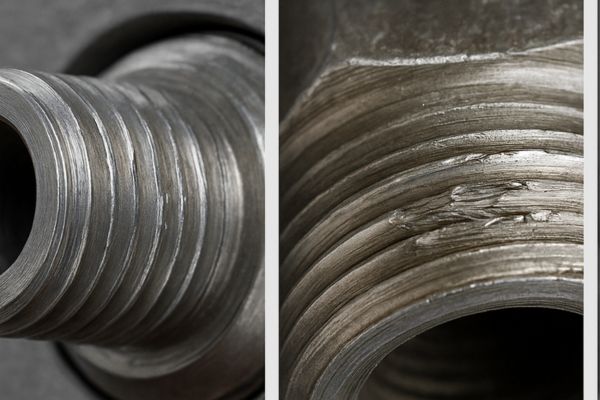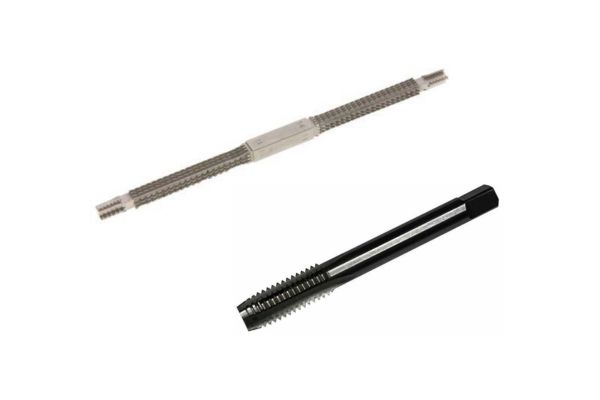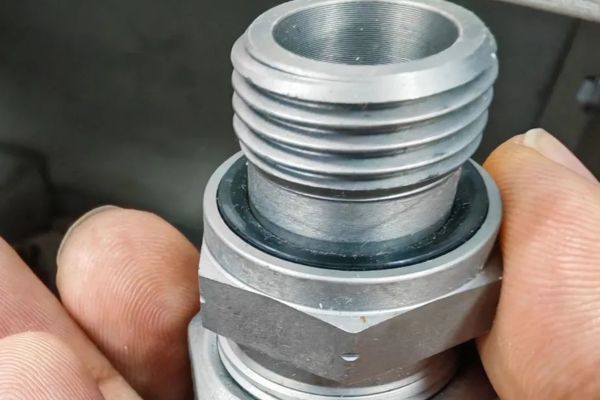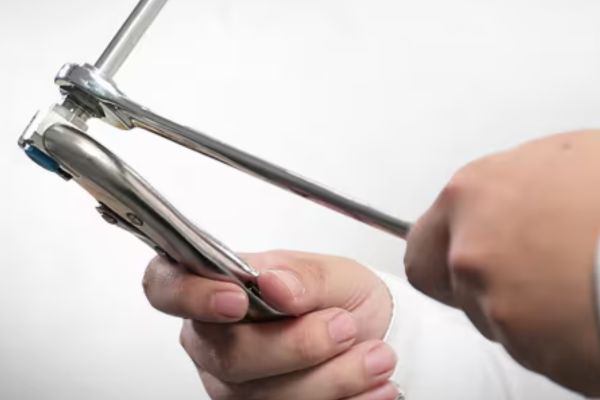A single stripped thread stops your machine cold. The part is expensive, and a replacement is days away. Every minute of downtime is costing you money, all because of a small strip of damaged metal.
You can often fix damaged hydraulic threads on the spot with the right technique. Minor damage can be chased with a file or tap, while severe cases can be permanently repaired using thread inserts, saving you time and money.
How Do You First Assess the Thread Damage?
You see a bad thread and immediately grab a tool. But using the wrong method can turn a small problem into a complete write-off. Rushing the diagnosis is a recipe for making things worse.
A careful 5-minute inspection is the most important step. It tells you the type and severity of the damage, which dictates the correct repair method. This simple assessment prevents you from wasting time or destroying the component.

Before you can fix the problem, you have to understand it. Is the thread just dirty, or is it fundamentally compromised? Is it a male fitting or a female port? Answering these questions will guide you to a safe and effective repair.
Identifying the Type of Damage
First, clean the area with a wire brush and solvent. Then, look closely to determine the problem.
| Damage Type | Visual Appearance | What It Means |
| Cross-Threading | Threads on one side look flattened or angled. The fitting feels tight but isn’t seated. | The fitting was started at an angle. The threads have been forced into the wrong path. |
| Galling / Stripping | Threads appear torn, ripped, or “smeared.” Metal may be missing. | Caused by high friction from over-tightening or lack of lubrication, especially with stainless steel. |
| Corrosion | Threads are rusty, pitted, and may have a rough, flaky texture. | The component has been exposed to moisture, causing the metal to break down. |
Essential Inspection Tools
You don’t need a lot of fancy equipment for a good inspection.
- Good Lighting: A bright flashlight or headlamp is non-negotiable.
- Magnifying Glass: Helps you see small cracks and the true condition of the thread form.
- Dental Pick or Scribe: Lets you feel for cracks, burrs, and the depth of the damage.
- Thread Pitch Gauge: Quickly confirms the thread size and pitch so you can select the correct repair tool.
To Repair or to Replace?
This is the most critical judgment call. A repair is not always the right answer. You must replace the component if you see:
- Visible cracks in the metal around the threads.
- Severe distortion of the port or fitting.
- More than 50% of the thread material is missing.
- The connection is for a safety-critical system (e.g., steering, braking).
When in doubt, replacement is the safest option. We can supply high-quality fittings and components to ensure integrity.
What’s the Easiest Way to Fix Minor Thread Damage?
A male fitting has a small ding on the first thread, and it won’t start. You are tempted to force it with a wrench, but you know this will cross-thread it and ruin the female port.
For minor dings, crossed threads, or dirty threads, a simple hand tool can quickly restore the connection. The goal is to reform the existing threads, not to cut new ones. This is the fastest and least invasive type of repair.

This is your first line of attack. Often, a thread isn’t truly damaged, just deformed. A thread file or a thread chaser can realign the peaks and valleys of the thread, allowing the fitting to engage smoothly. These tools are inexpensive, easy to use, and should be in every technician’s toolbox. They are designed to save threads, not remove them, preserving the part’s original strength.
Using a Thread File (External Threads)
A thread file is a four-sided file with different thread pitches on each face. It is perfect for fixing localized damage on bolts and male fittings.
- Identify the correct pitch on the file by matching it to the good threads on the fitting.
- Place the file on the damaged section.
- With light pressure, push the file along the path of the original threads.
- Do this a few times until the thread profile is restored. Use a lubricant or cutting oil.
Using a Thread Chaser (Internal and External Threads)
A thread chaser looks like a tap or a die but is less aggressive. Its purpose is to clean and reform threads, not cut new ones.
- Chaser Tap (Internal): Carefully start the chaser tap by hand into the female port. Turn it slowly with a tap wrench, using plenty of cutting oil. It will follow the existing threads and push them back into shape.
- Chaser Die (External): A hexagonal rethreading die is best here. You can turn it with a standard wrench. Thread it onto the good part of the male fitting, then run it back and forth over the damaged area.
How Do You Fix Severely Stripped Internal Threads?
The internal threads in an expensive valve block are completely stripped. Replacing the whole block will cost a fortune and take the machine out of service for days. This is a nightmare scenario for any maintenance team.
You can create brand new, stronger threads using a thread repair insert. This proven method involves drilling out the damaged hole, tapping it for the insert, and installing a new threaded coil. It’s a permanent fix for stripped threads.
The Helical Insert Process (e.g., Heli-Coil®)
This is the most common method. The kits come with everything you need.
- Drill: Select the drill bit specified in the kit and drill out the old, damaged threads completely.
- Tap: Use the special STI (Screw Thread Insert) tap from the kit to cut the new oversized threads that will hold the insert.
- Install: Use the installation tool to wind the new stainless steel threaded insert into the hole until it is just below the surface.
- Break Tang: Remove the installation tool and use the tang break-off punch to snap off the small tang at the bottom of the insert.
Using Solid-Wall Inserts
These are another excellent option. They are solid bushings, not coils, and are often seen as even stronger.
- Self-Tapping Inserts: These have cutting slots and tap their own threads as you drive them in with a bolt or special tool.
- Key-Locking Inserts: After tapping a standard thread and screwing in the insert, you drive small keys down the sides to lock it permanently in place.
| Insert Type | Advantages | Disadvantages |
| Helical Insert | Widely available, good strength, small finished hole size. | Requires special STI tap, can be tricky to install correctly. |
| Solid-Wall Insert | Very high strength, easy to install, often uses standard taps. | Requires a larger drilled hole, can be more expensive. |
What if the Port’s Sealing Surface is Damaged?
The threads in an SAE port are fine, but there’s a deep scratch across the cone-shaped sealing surface. You try a new hydraulic fitting with a new O-ring, but it still leaks under pressure.
If the precision sealing surface is damaged, fixing the threads will not stop the leak. You need a specialized port reseating tool to recut the surface. This tool pilots into the threads and shaves a thin layer of metal off the face, creating a fresh, flat surface for the O-ring.

This is a more advanced repair, but it’s essential for ports that rely on a face seal, like SAE ORB (O-Ring Boss), ISO 6149, and BSPP. The O-ring needs a perfectly smooth surface to seal against. Any nick, scratch, or piece of debris will create a leak path. A port resurfacing tool is the only way to correctly repair this type of damage in the field without disassembling the entire machine.
How Port Repair Tools Work
These tools are designed for precision. They have three main parts:
- Threaded Pilot: Screws into the existing threads of the port to perfectly align the tool.
- Cutter: A hardened steel cutter, shaped to match the exact angle of the port’s sealing surface (e.g., the cone for an SAE port).
- Guide: A body that holds the cutter and allows you to turn it smoothly, either by hand or with a wrench.
You simply screw in the pilot, slide the cutter down, and turn it gently to skim the surface until it is clean and smooth.
When to Use a Port Reseating Tool
Use this tool when you have a persistent leak from a fitting that relies on a face seal, and you’ve confirmed the leak is not from the threads or a bad O-ring. It’s the solution for:
- Nicks and scratches from improper tool use.
- Galling or damage from over-tightening.
- Corrosion or pitting on the sealing face.
How Do You Fix Damaged External Fitting Threads?
You dropped a heavy steel fitting, and the male threads are flattened on one side. You can’t start it into the port, and it’s a special component you don’t have a spare for.
For minor damage, a thread file is the best tool. For more significant damage, a hexagonal rethreading die can reform the threads. This allows you to salvage the fitting and get your connection made without having to find a replacement.

Repairing external threads is often easier than internal ones. The key is to use a tool that reshapes the existing metal, rather than one that tries to cut it away. Forcing a standard cutting die onto a damaged thread can make it worse by removing what little good material is left. A rethreading die is specifically designed to be less aggressive and follow the original thread path.
The Thread File Method
As mentioned before, a thread file is the first tool to try for external threads. It is perfect for cleaning up a single damaged spot or a crossed first thread. Its main advantage is precision; you are only working on the exact spot that is damaged.
Using a Hexagonal Rethreading Die
These dies look like a thick nut. They are better than a standard die stock for field repair because you can turn them with any wrench.
- Choose the correct size die.
- Lubricate the male threads with cutting oil.
- If possible, start the die on a good section of threads.
- Turn the die onto the damaged area. You will feel it working to push the threads back into shape.
- Work it back and forth a few times until it moves smoothly. Clean and test the fitting by hand.
How Can You Prevent Thread Damage from Happening?
You’re spending too much of your time fixing damaged threads. It’s frustrating and takes you away from more important preventative maintenance tasks. There has to be a better way than constantly reacting to problems.
The best repair is the one you never have to make. Simple preventative habits during assembly and disassembly can virtually eliminate thread damage. Cleanliness, care, and using the right tools are the keys to avoiding these frustrating repairs.
As a component manufacturer, we machine our threads to exact tolerances for a reason. Precision builds reliability. But that precision can be destroyed by a single moment of carelessness. Adopting these professional habits will protect the components, prevent leaks, and dramatically reduce the time you spend on frustrating thread repairs.
The Golden Rules of Assembly
- Clean First: Always wipe both male and female threads clean before assembly.
- Start By Hand: Thread the fitting at least two to three full turns by hand. If it binds, stop. Do not use a wrench to force it.
- Use Proper Lubricant: The correct thread sealant or lubricant reduces friction and prevents galling.
- Use a Torque Wrench: Follow torque specifications. Over-tightening is a primary cause of thread stripping and component damage.
- Protect Exposed Threads: Use plastic caps and plugs to protect threads on spare components during storage and transport.
Conclusion
Assess damage first, then choose your method: a file for minor nicks, a chaser for dirty threads, or an insert for major repairs. Prevention through careful assembly is always the best strategy.
If you are facing thread damage or need reliable hydraulic fittings, contact us today. Send us your inquiry, and our team will provide quick solutions and competitive quotations.
FAQ
How do I know if a hydraulic thread is damaged?
Check for flattened, torn, or corroded threads during inspection.
Can minor thread damage be repaired?
Yes, use a thread file or thread chaser to restore the threads.
What if the internal threads are completely stripped?
Install a thread repair insert like Helicoil or solid-wall insert.
What should I do if the sealing surface is scratched?
Use a port reseating tool to restore a smooth sealing face.
When should I replace instead of repairing?
Replace if threads are cracked, severely distorted, or safety-critical.
How can I prevent thread damage in the future?
Clean, lubricate, hand-start, torque properly, and protect threads.





